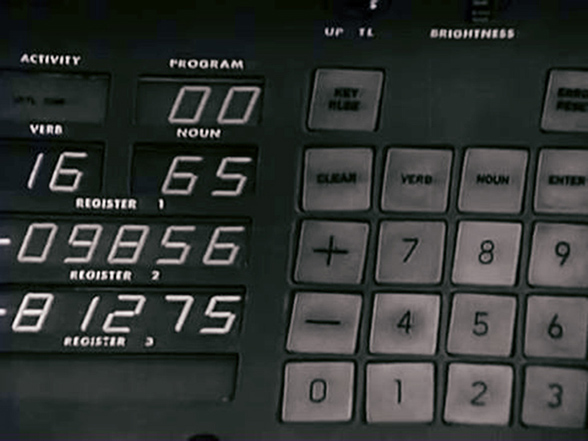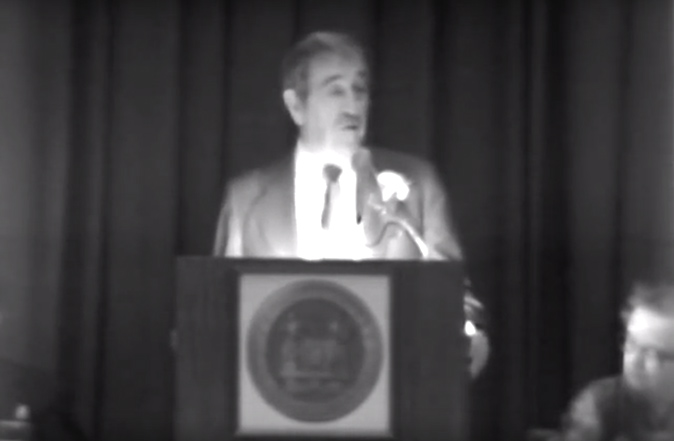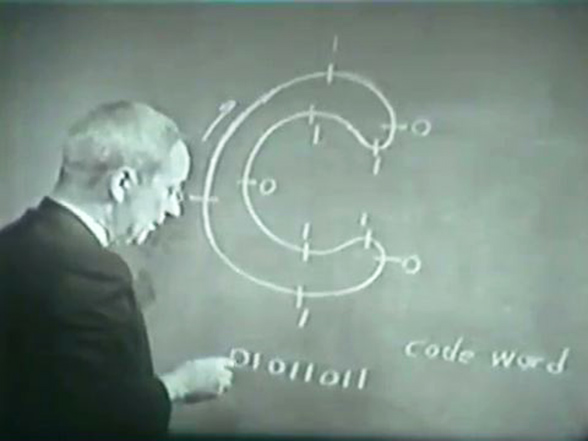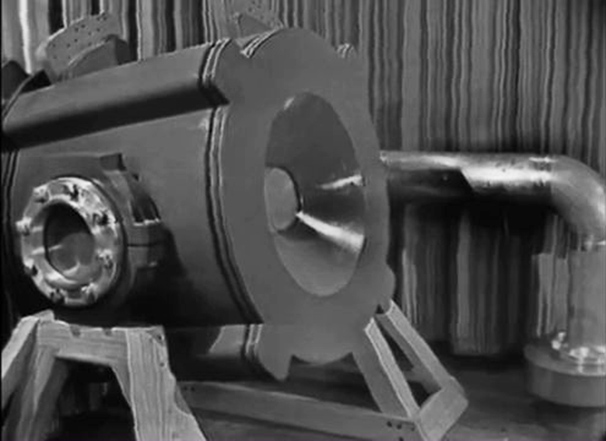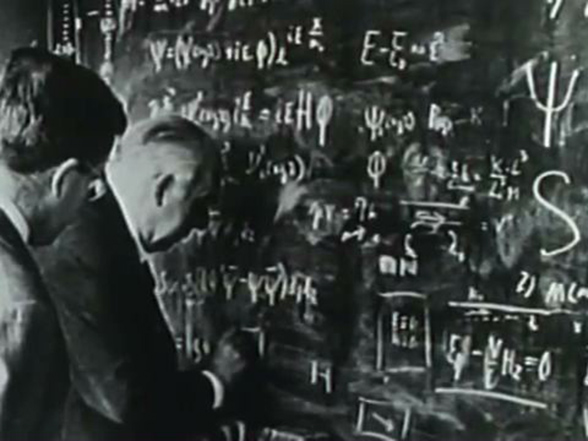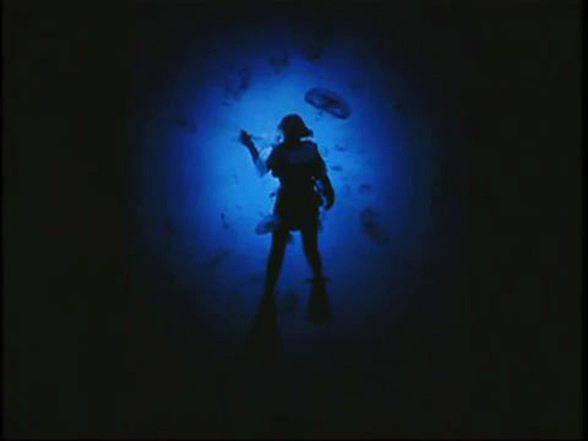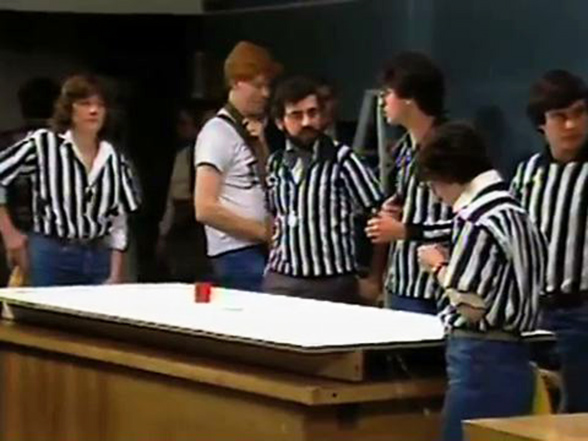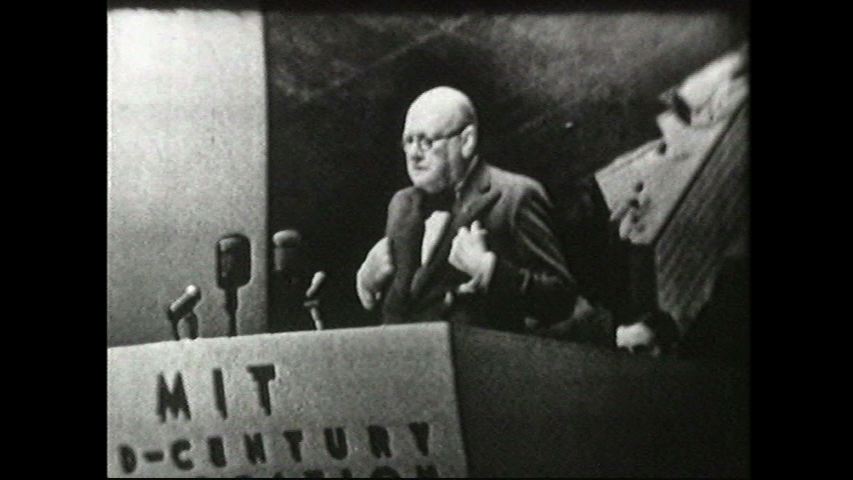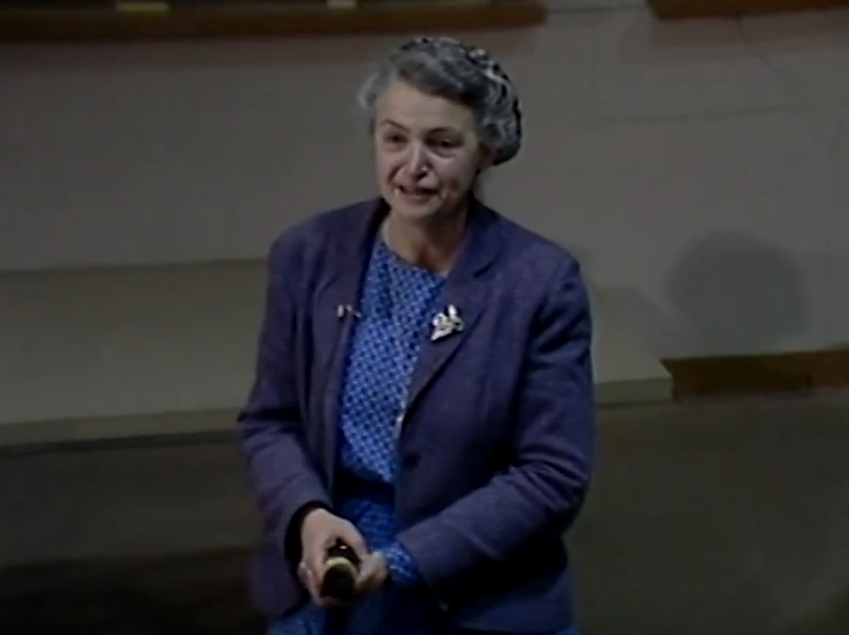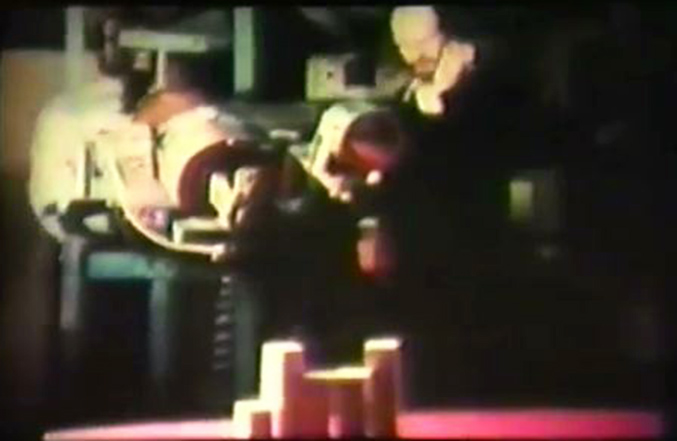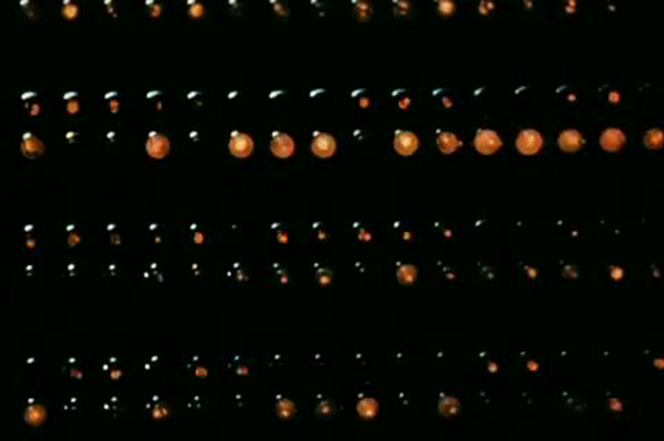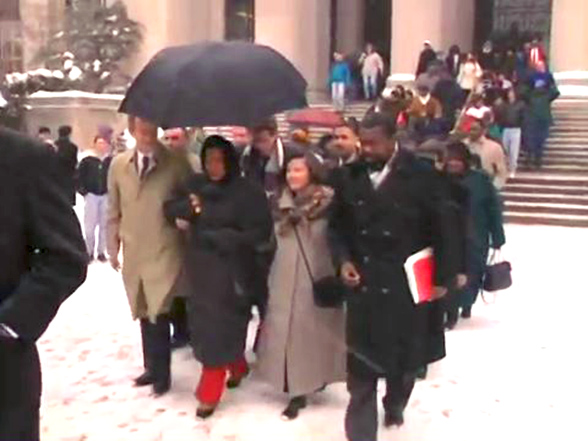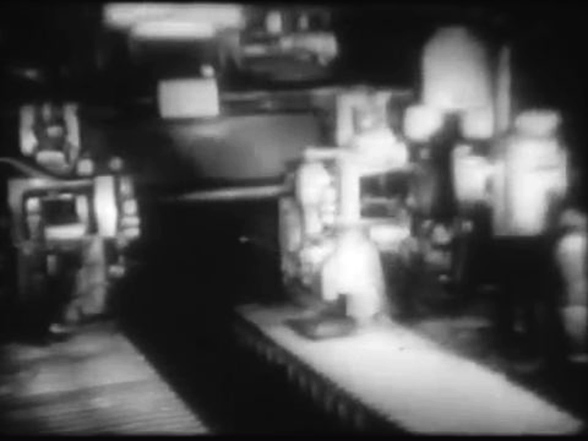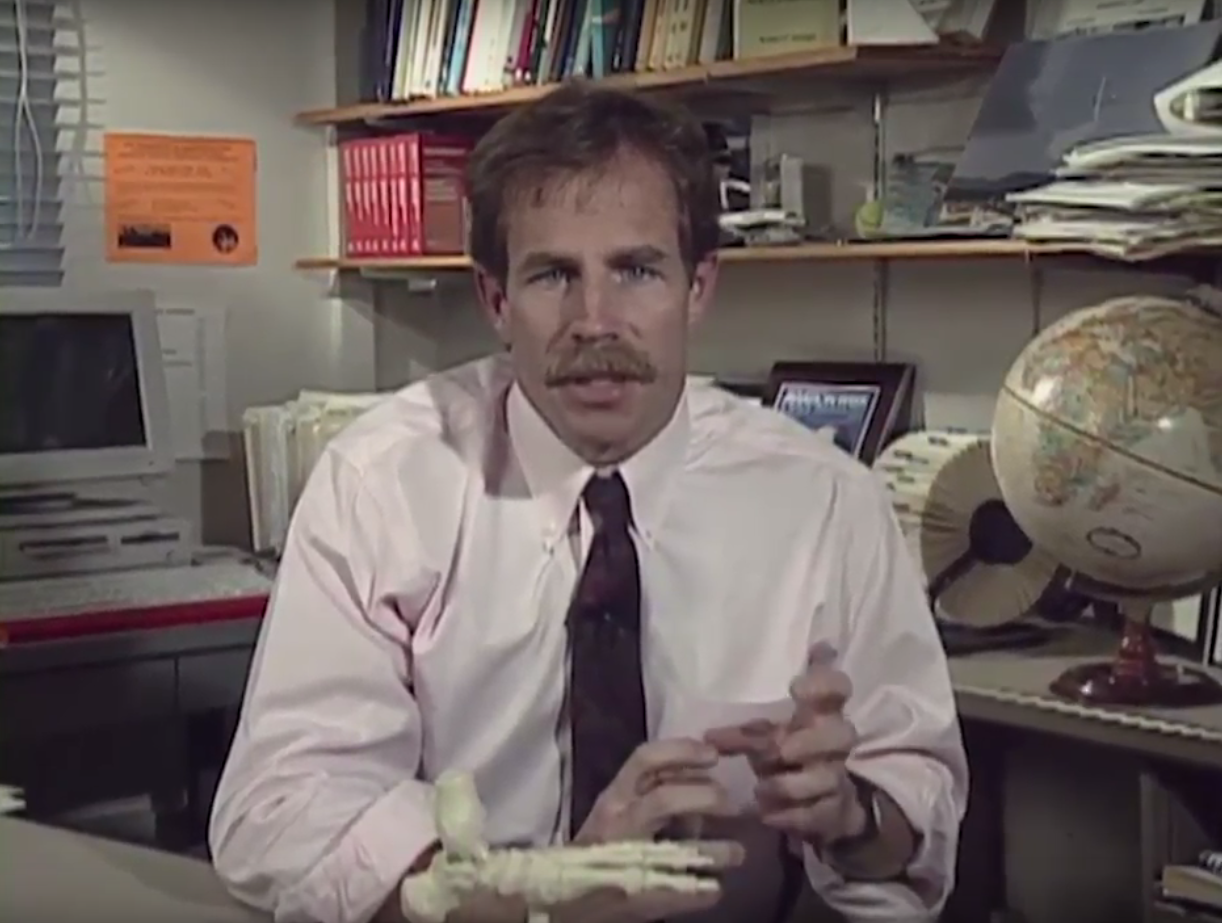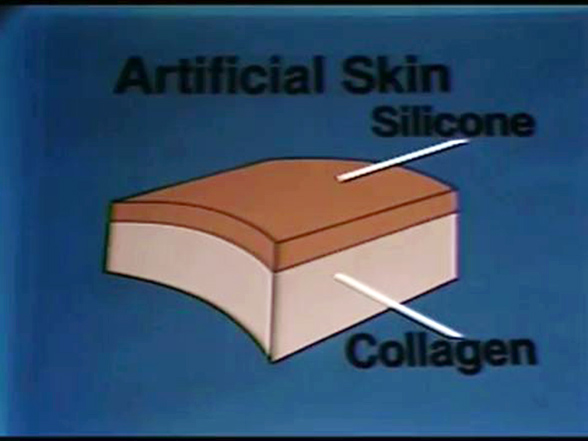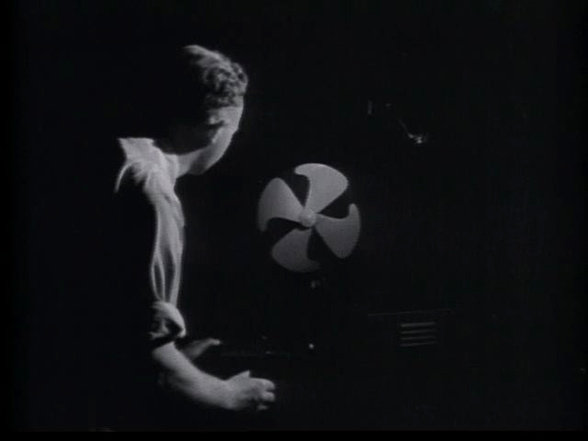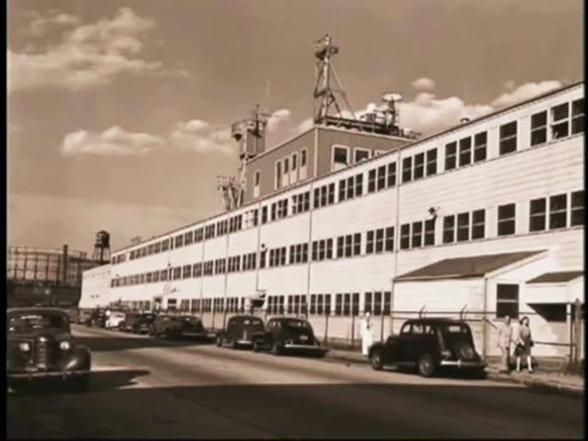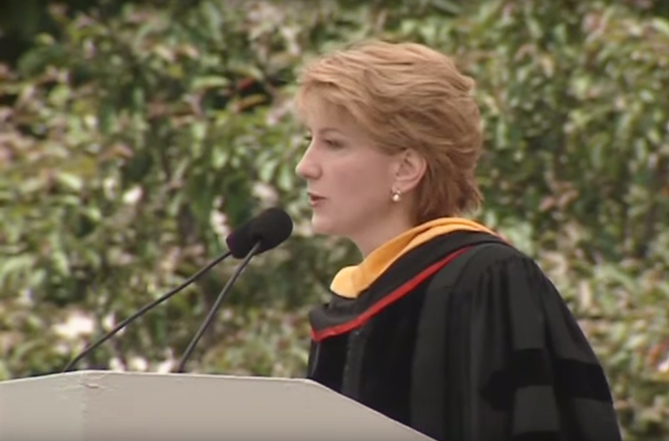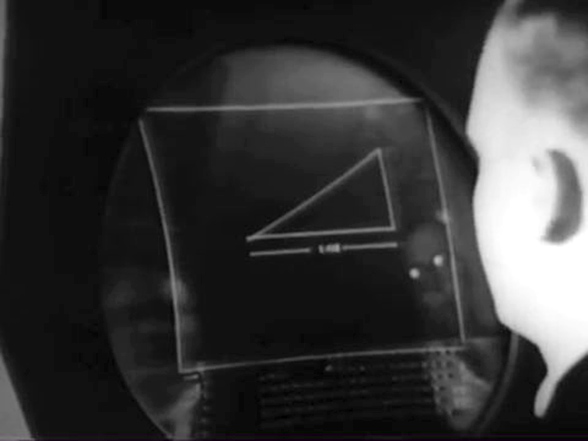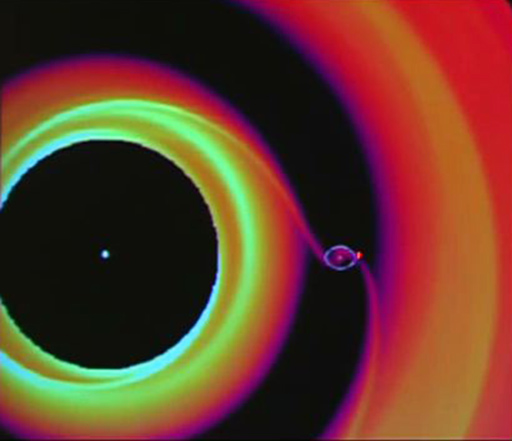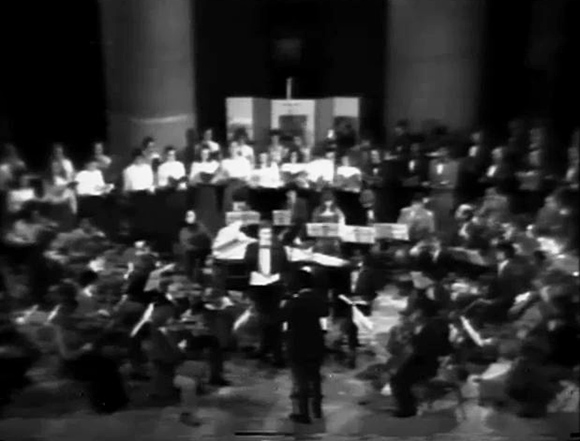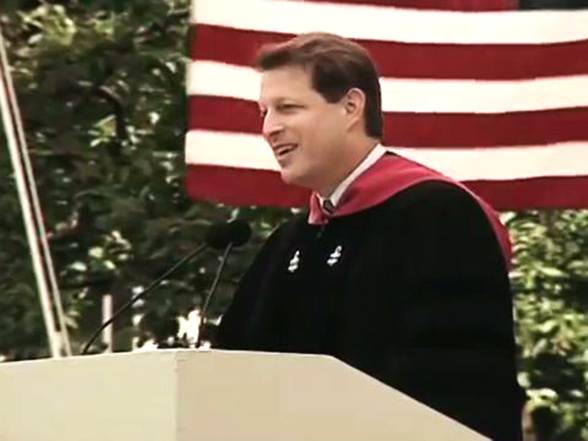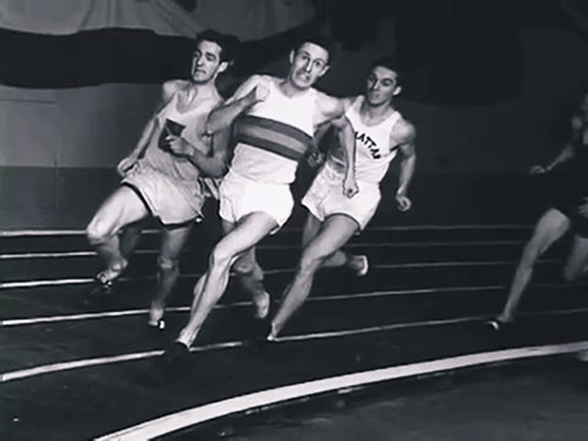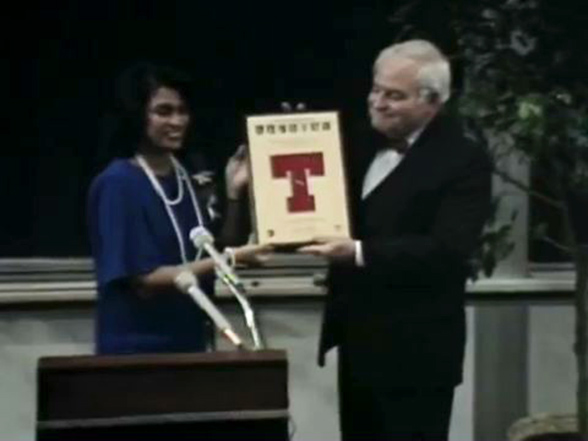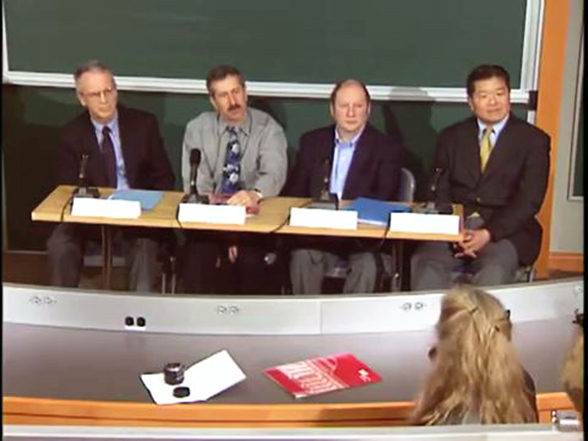MIT Science Reporter—"Sailing by Computer" (1966)
JOHN FITCH: This is a carefully made model of a Bermuda racing yacht being pulled along in a ship model towing tank. As it moves through the, water instruments measure the drag of the water along the hull. These measurements fed into a computer and combined with wind and sail information can now be used to predict the yacht's performance in an actual race. How modern Naval architects are using facilities such as tow tanks and computers to get an ever faster sailing yacht is our story today in Science Reporter.
[MUSIC PLAYING]
Hello, I'm John Fitch, MIT Science Reporter. Today we're at MIT's ship model towing tank in Cambridge, Massachusetts to learn what new techniques naval architects are using to design ever faster and faster sailing boats.
The famed 12 meter boat is, without doubt, the aristocrats of the racing fleet. Her sleek hull usually runs about 70 feet with a mast nearly twice that high. She's generally crewed by 11 men and alone is eligible to compete in that most revered of all yachting contest, the America's Cup Race.
Back in 1851 the visiting United States schooner America let a fleet of British boats around the 53 mile course of England's Isle of Wight, coming home with the Royal Yacht Squadron's Cup. Four years later the victors gave the cup as a perpetual challenge trophy and provided probably the greatest single stimulus to the continued development of yachting.
Before 1870, yachts we're usually turned out my rule of thumb, each builder having his favorite type. Once the Cup races were on, the infant science of naval architecture came to be applied to yachting. Names like Smith, Burgess, and Herreshoff were linked with one successful design after another.
Certainly, no less important than the revolution in hull design was the development of modern rigging. By 1920, aerodynamic principles were being applied to sail plans and tall, narrow sails with long leading edges replaced the old broad-based gap rig. Large, parachute-like spinnakers supplanted their small, flat predecessors.
One might suppose that the giving the racing yacht more than a century of well-focused attention naval architects would consider this a job well done. This is far from the case in a world where tenths of knots can make winners of losers and vice versa.
To learn more about how naval architects are making use of modern design techniques to catch up with these elusive fractions of knots, we talked with Mr. Halsey Herreshoff, an instructor in the Department of Naval Architecture at MIT.
HALSEY HERRESHOFF: Well, in the design of any racing yacht there are two factors of the most important. Number one is the sails, and secondly the hulls. The sails have to be designed, or trimmed, in such a way that there's a large forward thrust, hopefully without a large side force. And the hulls, it's most important that they be designed and shaped such that the drag force, or the resisting force, of the water where its motion forward is small in order that the can sale at high speed.
For a hull such as the one we have here, which is a to one tenth scale model of a 40 foot racing boat, I think you can see that for the designer there are many possible choices. You could have a variation of beam or of draft or of the shape of the sections or other way the sections are combined.
So, I think that it's evident that it's quite a difficult problem to decide what is the best boat. Secondly, once a boat has been designed it's quite a problem to determine how it will perform. What drag side force would be on the hull.
JOHN FITCH: This isn't something that you could write a nice little mathematical equation for and put it in a computer and come out with the best design.
HALSEY HERRESHOFF: I'd like to say that we had a way of doing that but, unfortunately, since we can't do that, at least yet, we must resort to experiment. That's why we make these scale models of proposed designs and tow them in the model tank, measure the forces, and from that means, make a prediction of the full size forces and performance.
JOHN FITCH: Let's talk about some of these forces but you might measure. What would they be?
HALSEY HERRESHOFF: The forces on the hull are, really, such that we can divide them into two portions. There's first of all, a frictional drag, which is the resistance caused by friction the water moving along the surface of the hull. And, in addition to that, there is a wave drag.
JOHN FITCH: What's a wave drag?
HALSEY HERRESHOFF: That is the force that is required for the energy that is used to form the waves that are familiar going along behind any ship or hull that's under way.
JOHN FITCH: That's just wasted energy, then. I never thought about that.
HALSEY HERRESHOFF: Well, let's right. Those waves which--
JOHN FITCH: They look so pretty.
HALSEY HERRESHOFF: They look pretty to people, but it's the object of every naval architect to reduce those waves because by reducing the waves he can also reduce drag and have a boat the performs better.
JOHN FITCH: Are there any other things would you'd want to measure?
HALSEY HERRESHOFF: Well, yes there are. Not only is it important that the hull have a small amount of drag, but it should be such that it has a considerable resistance to motion to the side. That is why we build the hulls with a keel of this form and in some cases even an extra piece below, in this case a centerboard, which resists motion to the side. This can go up and down and when the boat is sailing in such a way that you want to resist side force it put into the position shown here.
JOHN FITCH: What is this? What causes this side force that you have to resist?
HALSEY HERRESHOFF: The side force is a result of the forces on the sails. Unfortunately, even the best sails in order to have a satisfactory force forward have, along with that, a considerable force to the side.
JOHN FITCH: That's right, you're not always going right along with the wind, are you?
HALSEY HERRESHOFF: No, that's right.
JOHN FITCH: It's pushing you to the side somewhat. So, why don't you just make this bit as big as you can until it hits the bottom?
HALSEY HERRESHOFF: As in all engineering problems, there's a matter of compromised. Certainly, as you suggested, if this came on up a bit even further there would be more side force possible but along with that the drag would be increased. So, the designer tries to choose an optimum combination, and that combination is chosen not only from the standpoint of the performance of the boat, but also you must devise a boat that performs well within the handicap system that is set by the rating rules under which these boats race.
JOHN FITCH: For a particular classical of boat.
HALSEY HERRESHOFF: Particular class of boat, that's right.
JOHN FITCH: Now, would an architect just bring you one boat?
HALSEY HERRESHOFF: No, in order for an architect to really find out very much here, he should bring us several models. And he might bring us model, or one with a deeper draft or one with a different shape to the hull. I can show you another model that we have set up here in the position ready for test.
You'll see that, as it's located here, it is free in pitch and in roll much as a boat would be free actually sailing out on the water. We make a connection to model to the carriage with three locations. This link forward goes to a transducer which we use to measure the drag force.
JOHN FITCH: Right.
HALSEY HERRESHOFF: And there are similar transducers, one at the bow and one at the stern, which we use to measure the side force. In each of those transducers is a mechanical electrical device with lead wires that go up carriage and there to our control station.
You'll see that the model is connected with these pairs of arms such that it can assume a variety of attitude and those attitudes can be equivalent to the actual sailing conditions.
JOHN FITCH: Could we actually see one of these runs?
HALSEY HERRESHOFF: Yes, we said he could. Hank, would you please run the model back and make a run?
In an actual series of tests to evaluate a hull, we make runs at quite a variety of conditions. In fact, we make 90 different runs for each hull.
JOHN FITCH: 90?
HALSEY HERRESHOFF: 90. That's because we have to try to simulate all the possible attitudes and speeds that we would have for any boat actually sailing. So, we run it at ten different speeds and nine different combinations of keel yaw angle. The yaw angle is the angle between the boat center line an the direction of travel.
This particular run simulates a sailing to windward condition.
JOHN FITCH: Listen, I'm a land lover I'm afraid. Is that into the wind?
HALSEY HERRESHOFF: Yes, sailing to windward is into the wind, or at least about 40 degrees of the wind direction. You can see the boat is heeled and going along much as she would actually under way.
JOHN FITCH: This is fine in a nice, calm towing tank, but actually a boat may be out in the ocean and there would be waves another factors, wouldn't there?
HALSEY HERRESHOFF: That's right, and while much of our research is done here in calm water as was the last run, we now are devising waves, and making testing waves. If you'd like we could start the wave maker up and show that.
Hank, would you start the wave maker and we'll have waves along with this run. We'll be running the model at the same speed and attitude as last time, but this time we will have waves.
JOHN FITCH: I can see the waves coming along my end anyway.
HALSEY HERRESHOFF: You can see them running along here and Hank will wait just a short time here, until the waves to get down to the location of the model and then he'll start forward again.
JOHN FITCH: All right.
HALSEY HERRESHOFF: Now you'll notice that the motion of the model in these waves looks rather nervous, rather quick.
JOHN FITCH: Yes.
HALSEY HERRESHOFF: And that is because the time scale really needs to be adjusted along with the scale of the model in order to have it look the way it would out on the water.
JOHN FITCH: I see. Not only does the boat itself have to be stretched out to become a real boat, but time itself has to be stretched out.
HALSEY HERRESHOFF: That's right.
JOHN FITCH: But how do you do all this scaling up to the real thing? Is it just a matter of multiplying the length of this times the scale?
HALSEY HERRESHOFF: Well, first of all, why don't I show you the controls that we have in our control room which we use to measure the forces, and then from there we can talk about, perhaps, how we will expand the results to full size. Let's have a look at the control room.
Incidentally, many different types of experiments are conducted here, but they're all run in this same control room. These instruments are used to measure the forces. This top one is an electronic counter and on this we can make a measurement of the drag force. The next one gives the side force of the bow and this one the side force of the stern. The instruments down below are amplifiers and converters for the signal that comes in from the carriage and goes on up to the electronic counters.
This is a telescope through which we can site the model and line up some cross hairs in order to determine the heel angle because, of course the heel angle is an important factor.
The actual run is controlled here. We have levers that control speed, and once the run is begun in this fashion everything goes automatically. There's a switch, which is tripped by the model, and as that happens, you see the signal starting to come in.
Now, the signal for all the forces is summed over the entire period of the run. Finally, as the model gets down toward the end, it'll trip off a switch which is the end of the run, and that then gives us the total we get for all of the different forces on that particular run.
JOHN FITCH: Is measured in pounds?
HALSEY HERRESHOFF: No, it comes out in a number, in this case 22904, which isn't pounds, but it's proportional to the drag force. In order to convert it, we have to divide by the length of time to run and also by calibrations of an amount of these. We do that by means of the computer.
The next step after we leave here is to punch the data onto cards, and by that means, send them to the computer. This is a sample of the results that come back to us from the computer, and you'll see that the calculations here are divided into columns for the model and the others for the yacht.
JOHN FITCH: This is what the computers has predicted over here.
HALSEY HERRESHOFF: That's right. This is what the computer has predicted based on our model measurements. Here is the run number, and next the yaw and heel which describe the attitude of the model under way. The speed, in this case, 2.689 knots and a tow force of 0.812 pounds.
JOHN FITCH: That's very much force is it?
HALSEY HERRESHOFF: It's not very much, but of course, it's quite a small model.
JOHN FITCH: Right.
HALSEY HERRESHOFF: In this case, there was no side force because the model was just running upright and straight ahead. Then, from these values a prediction of the yacht speed-- 6.59 knots-- equivalent to the slowest speed of the model, and we get a tow force indicated of 147 pounds.
JOHN FITCH: I see, and then no sideforce, again.
HALSEY HERRESHOFF: No, we get no sideforce, but in later runs we will have side force when the model runs at different attitudes.
JOHN FITCH: But, how do these computed values compare with what actually happened if you build it?
HALSEY HERRESHOFF: Well, of course, as in any field of research, we're always interested to find out whether or not I predicted values correspond with actual fact. Toward that end, we've just conducted a very interesting experiment.
We made a full size test of a 32 foot boat. The picture here shows that boat positioned at the David Taylor model based down in Washington, DC.
JOHN FITCH: This is not model, this is a full-sized boat?
HALSEY HERRESHOFF: This is an actual boat.
JOHN FITCH: This must be a tremendous towing tank.
HALSEY HERRESHOFF: Well, it is. The tank is about a half a mile long and 52 feet wide. You can see a person standing here puts it into scale, and the boat is mounted there, just as we would mount it here in the tank, and we've conducted full-size force measurements and are make comparisons between theses and equivalent measurements made here at the model tank.
JOHN FITCH: And how does it look?
HALSEY HERRESHOFF: We haven't got the results completely finished yet, but preliminary comparison looks very close.
JOHN FITCH: Well, if you design the hull correctly that's half the battle, as you said. Now what about the sail?
HALSEY HERRESHOFF: Let me show you some of the models and things that we've used in studies of sails.
JOHN FITCH: I could understand how a sail works when you're going along with the wind. The wind sort of pushes on the canvas and makes you go, but I wish you'd explain to us how it is that you can make a sailboat go into the wind, or up wind or whatever you call it.
HALSEY HERRESHOFF: Part of a time when we sail we go along with the wind directly behind us or at a slight angle. In that case the wind operates on the sail just to push it along, but at other times, more normally, we sail at different angles to the wind. In that case the action of the wind on the sails is much like that on an airfoil or on a wing?
JOHN FITCH: You mean It works like an airplane wing?
HALSEY HERRESHOFF: It really works like an airplane wing. I think this little model it's a good way to visualize that. The wing, when situated on an airplane is subjected to flow that comes along in this fashion, over the top of the wing and also over the bottom so that there's a difference in pressure on the top and the bottom surfaces, which results in a lift to support the airplane.
We can take that same wing and rotate it in this fashion, around to the attitude that it would have when on a sailing yacht. Let's represent this edge as the center line of the sailing yacht and the wing, of course, is the sail. The wind might come in at about this angle so that this flow around the leeward side of the sail, and also the windward side. That results, again, in a difference in pressure so that because of the low pressure leeward and the high pressure windward, there is a force directed in about that way.
JOHN FITCH: I see. That's sort of partly pointing forward and partly to the side.
HALSEY HERRESHOFF: That's right, and of course it's the forward component of that total force that we really want to make large so that we can get high speed out of the boat.
JOHN FITCH: So, the boat is actually going in the direction the wind is coming from. The part that's always absolutely puzzled me.
HALSEY HERRESHOFF: The boat goes along that way, and of course, associated with that driving force, there is the component side which, as we saw before, has to be resisted by the heel of the boat or by a centerboard.
JOHN FITCH: So the boat doesn't just sort of sideways in the water. That's very interesting. It really works like wave in there.
HALSEY HERRESHOFF: Besides our research on hulls here at MIT, we're doing some research on sails. As a part of that work, we set up models-- much of this form, but they're the larger models-- at the Wright Brothers wind tunnel and make tests to make determinations of the forces to be expected on sails of different forms. In those tests, we set the model up in about this fashion and change the attitude, which would correspond to a change in trim of the sale or a change in the heading of the boat, and we also run at different wind velocities.
JOHN FITCH: You try different shapes and sizes and things as well?
HALSEY HERRESHOFF: That's right. We very number of things. For one thing, we vary the amount of camber. That is the distance of offset of the sail, here, from the line through the leading edge and the trailing edge. In addition to that, we can vary the position of the camber, whether it's up forward, here near the master, or near the back.
JOHN FITCH: I see. But a real sail isn't really shaped like long thing like that. I think of them more as triangular, more like these models.
HALSEY HERRESHOFF: That's right, and for that reason we also test in the wind tunnel a more complete model, such as this one of the 12 meter boat. This is a 150 scale model with the rigging exactly like a real 12 meter boat, but the sails in this case are solid rather than fabric.
JOHN FITCH: Why is that?
HALSEY HERRESHOFF: We found that, rather surprisingly, it's not possible to build a fabric model sail and have it perform to the proper shape in the wind tunnel that it would have out sailing. So, to make tests of known sail shapes and chosen sail shapes we construct these solid sails, and then we can get forces correspond to whatever shape we want.
In the wind tunnel, we tip the model at various heel angles and, also, we have means to turn it through different angles of attack. I think it's sort of interesting, though, to point out that while here in the model tank the tests are conducted with a model under way and the water fixed, in the wind tunnel we move the air and keep the model in the same place.
JOHN FITCH: But, otherwise, they are rather similar.
HALSEY HERRESHOFF: Otherwise the tests are equivalent.
JOHN FITCH: Do you take the same sort of measurements and put them into a computer to see how real sails work?
HALSEY HERRESHOFF: That's right, very much equivalent to the hull work. We process the data, the measurements and produce predictions and the full size forces be expected on different kinds of sails. Now, in addition to that, we've been doing another rather interesting type of test with the sails. We make use of another model, which I have here, it's right behind you if you'd pass it out.
JOHN FITCH: This is a beauty. One of my kids would love to have this.
HALSEY HERRESHOFF: I'm sure they would. This is a model, much like the bigger one, but it was built for a set of tests that we did down and the smoke visualization tunnel at Philadelphia Naval Shipyard. Those tests were strictly for the purpose of enabling us to visualize the flow around sails. We put the model into a tunnel where the air flow comes in about this direction and with the airflow are streams of smoke. It's very interesting and very instructive to watch how the smoke streams are deflected around the leeward and windward sides of the sails. I have a film which was taken during some of those tests which show the flow patterns in a way that we're really not able to see when we're out sailing a real boat.
JOHN FITCH: All right, let's look at it.
HALSEY HERRESHOFF: The air is shown by the streams of smoke. it's coming from right to left and we're viewing the boat from the leeward side. The boat is heel toward us and is progressing as though she were going to the right.
JOHN FITCH: I see.
HALSEY HERRESHOFF: One of very interesting things about being studies is the indication of that the air is bent, not just at the leading edge of the sail, but actually is bent quite a ways out forward of the sail.
JOHN FITCH: It's interesting, the air is actually affected out in front of the boat itself.
HALSEY HERRESHOFF: That's right, and also quite a ways on each side of the sail, to windward and to leeward. Another interesting thing is that tip vortex that you see the top of the sail. That a phenomenon common to every lifting surface. That is because of the difference in pressure on the two sides there is a rotary, or vortex, motion at the tip.
Here, the boat is positioned as though running before the wind, or with the wind. Again, we're viewing from the bow and the air, shown by the smoke streams is coming toward us. This is not exactly an ideal spinnaker, in fact it's a transparent Mylar sail that was shaped around my nephew's basketball, but at least it's a shape which indicates the flow that exists around the spinnaker. It's been very useful to us to make these observations, to show the form of the flow around the sails of an actual boat.
We've looked at two types of research here. Research on yacht hulls and also on the sales of the yachts. Now, we have a means to combine the results of this research into a prediction the actual performance of a boat. For that purpose we can use this time sharing computer console. By calling me computer at the other side of the campus at the MIT computation center by telephone we can establish communication and use the typewriter to introduce problems and get back the solutions directly here.
JOHN FITCH: I see, and there are other people at other locations who may also be working on problems at similar consoles.
HALSEY HERRESHOFF: That's, right we can all work at the same time and the computer, as a matter of fact, sorts out whose problems and what to do that each time, and it do several problems at once. The first step for us will be to tell a computer which one of our various programs we wish to use. For that purpose we will type in Logo SMGA. That tells computer to choose from its storage of program one that's called SMG, standing for speed made good to windward. In a moment it will give us an indication that it's picked out the right program and then we can go ahead with our problem.
JOHN FITCH: Right now it's going and looking for your program that solves these problems.
HALSEY HERRESHOFF: That's right. Now it types execution and then, as usual, the computer is very polite and it says, please type 0 to continue or 1 to stop. We'll type 0 and let it continue. That's an order for it to proceed to the next step in the program and it now has typed please type the hull test number. It's asked us to give it the values which have been determined from tests for any particular hull that we want to deal with.
I suggest we do a problem on the same hull that we look at test results of earlier.
JOHN FITCH: Oh, right this is that same one.
HALSEY HERRESHOFF: This is that same one. If you'd tell me what the number of that test is we will communicate it to the computer.
JOHN FITCH: This one here, 81.
HALSEY HERRESHOFF: 81. Now, the computer will search through its file of many test results and it's already gathered all the information it needs about the hull. But it wants to know what are the sails that we're going to put on this boat. I can remember that for this particular boat the sail area was 305 square feet.
Next thing it wishes to know is the height of the center of effort on the sails. In this case that was 16 feet.
JOHN FITCH: For the center of gravity or where the wind might be acting if you concentrated it all in one place.
HALSEY HERRESHOFF: That's right. Then, the third item that needs to know is a value that indicates the righting moment of the hull, the tendency of the hull to right itself when heeled by the sale forces.
JOHN FITCH: Oh, I see.
That number, in this case, is 320. Now, to be sure that values have been properly communicated to the computer, it will type back a systematic listing of these numbers. You can see it says the sail area is 305 and the sail vertical moment on is given here as 16 and the righting moment value is the same one that we introduced, 320. Now the computer console is typing a heading from the calculations that we want to make.
JOHN FITCH: I see. Speed made good to windward.
HALSEY HERRESHOFF: Speed made good to windward. To visualize the problem, let's make use of this little model and why don't we pretend that the wind is coming from a direction over there beyond the typewriter. Let's say that you're sailing the boat and you want to arrange things to sail to windward as fast as possible.
JOHN FITCH: I want to go that way, into the wind?
HALSEY HERRESHOFF: You want to go that way.
JOHN FITCH: Well, I don't think you go right that way.
HALSEY HERRESHOFF: First of all, I ought to ask you what should the wind velocity be? Of course, actually, when you sail a boat you don't usual have the chance to pick the wind velocity but we'll let you pick it.
JOHN FITCH: Oh, I don't know. You pick a number.
HALSEY HERRESHOFF: Why don't we say 15 knots and type that in. Now, the next thing that you've got to decide is how you're going to sail with reference to the wind. Are you going to sail at a wide angle or across the wind?
JOHN FITCH: Oh, I see what you mean. Go over that way and then come back. All right, let's go out in that direction.
HALSEY HERRESHOFF: All right, we'll start out sailing at about 60 degrees, then.
JOHN FITCH: All right.
HALSEY HERRESHOFF: I type in 60 and Now the computer does a rather lengthy calculation. I say lengthy because it would take us several hours, but completed almost immediately, and you'll see the result here is that the boat speed is 7.2 knots, but the component, that is in the useful direction, the speed to windward is only 0.16 of a knot.
JOHN FITCH: I see, I'm going off in a great rate off this direction but I'm not making much progress in the way I want to go. I'll head up into the wind, then
HALSEY HERRESHOFF: Fine, we'll sail a little higher to the wind. Well, then let's say the wind velocity is the same as before, 15, and now we'll sail at, let's say, 30 degrees. Oh We'll see that as compared to last time the boat speed is somewhat less, 6.09 knots compared to 7.2, but the useful part of it is now 4.12 knots.
JOHN FITCH: All right, let's really point into the wind. I'll head up this way.
HALSEY HERRESHOFF: All right, so you're getting a very high, about 10 degrees. I'll type that value in and let's see what the resulting sailing is. The computer has written notice. It says you are in irons, bear off. That is exactly the conclusion that you'd come to if you try to sail a boat out on the water as close as 10 degrees to the wind.
We could try many different choices of heading and, finally, we'd arrive at one that was an optimum for the best speed made good to windward and that would be the way you actually want to sail the boat. We could make a similar calculation for other boats and determine what choices are best for a good performance.
JOHN FITCH: Thank you very much, Mr. Herreshoff.
Today we visited the MIT ship model towing tank. Our guest has been Mr. Halsey Herreshoff. I'm John Fitch, MIT Science Reporter.
[MUSIC PLAYING]
